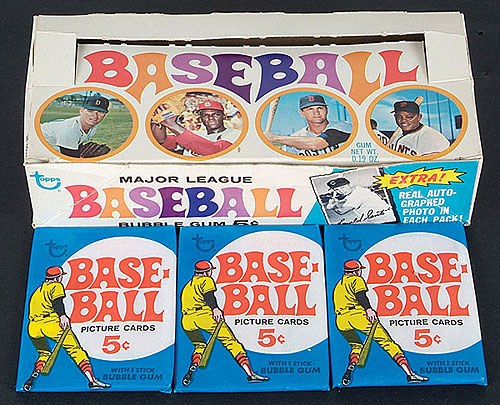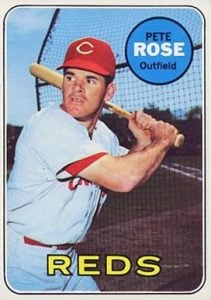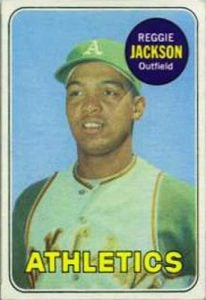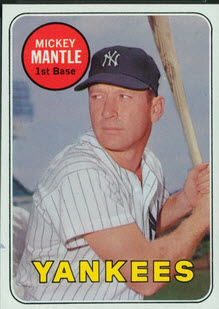When collectors peeled open their first wax packs of 1969 Topps baseball cards as clubs wrapped up Spring Training, America was already getting anxious for the moon landing that seemed imminent and would unfold that summer. Little did baseball fans know that they were about to bear witness to developments in the game itself that were nearly as monumental as exploits of the Apollo 11, at least in the mind of a diehard.
Before the season even began, M ickey Mantle retired and, by the time October rolled around, the first-ever divisional champions had been crowned. But that bewitching month held the biggest prize of all, as the lowly New York Mets transformed into the Amazin’s to take down the powerful Baltimore Orioles and capture the World Series title.
ickey Mantle retired and, by the time October rolled around, the first-ever divisional champions had been crowned. But that bewitching month held the biggest prize of all, as the lowly New York Mets transformed into the Amazin’s to take down the powerful Baltimore Orioles and capture the World Series title.
As the summer wore on, you can be sure that little leaguers everywhere dug deep into their piles of 1969 Topps cards to figure out just what a Swoboda or Tug looked like.
Hold the Burlap
The 1969 Topps cards featured a fairly simple design that shared much in common with their predecessors from the year before, with one important difference. While the the 1968 treated collectors to a thatched brown/beige/pink border that reminded of a burlap sack, the 1969s fell back to the standard solid white margins.
Within those walls, each card showcases a large color photo of the featured player, with the team nickname in large block letters near the bottom. In the upper left or right corner of each card front, Topps placed a colored circle that contains the player’s last name in large type and his first name and position in a smaller font and a different color.
It’s an uncluttered layout that throws focus on the image and also brings to mind the 1967 Topps set.
On the flip side, card backs are pretty standard for Topps issues, though the color scheme is a bit jarring. Featuring black type on a pink background, each horizontal reverse leads off with the Topps logo and card number in the upper left-hand corner, butted up against a white rectangle featuring the player name and vital stats. Beneath those is a block of text highlighting the player’s career, and the top two-thirds of the card is finished off by a player cartoon on the right-hand side.
off with the Topps logo and card number in the upper left-hand corner, butted up against a white rectangle featuring the player name and vital stats. Beneath those is a block of text highlighting the player’s career, and the top two-thirds of the card is finished off by a player cartoon on the right-hand side.
The bottom of the card is dedicated to a block of complete player stats, which can take up nearly the entire card back for long-toothed vets like Mantle.
Which One Was the Straw Again?
As it turns out, that Mickey Mantle card (#500) would be his LAST regular issue, making it one of the more popular cards in the set, and of the late 1960s.
Of co urse, baseball card sets are largely driven by rookie cards, and the 1969 Topps issue comes through with the man who would eventually pick up Mantle’s mantle as the New York Yankees’ slugger in chief. On card #260, though, Reggie Jackson is just an Oakland Athletics prospect with no discernible swagger for the guy who would soon be the “straw that stirs the drink” for a run of World Series champs.
urse, baseball card sets are largely driven by rookie cards, and the 1969 Topps issue comes through with the man who would eventually pick up Mantle’s mantle as the New York Yankees’ slugger in chief. On card #260, though, Reggie Jackson is just an Oakland Athletics prospect with no discernible swagger for the guy who would soon be the “straw that stirs the drink” for a run of World Series champs.
Today, the last Mantle card and the first Reggie card live on together as the keys to the 1969 set. The Mick typically sells for close to $1000 in slabbed NM-MT condition, while Reggie can fetch $1500 in similar grades.
Aside from those book-ended sluggers, key cards in the ’69 issue include the Rollie Fingers rookie card (#597), Nolan Ryan’s second card (#533), Johnny Bench’s second card (#95), the third-year Tom Seaver card (#480), and big names of the era like Roberto Clemente (#50), Willie Mays (#190), and Pete Rose(#120).
One rookie card that got an unexpected bump in activity late in life is #237, Bobby Cox. Though Cox played in parts of only two big league seasons, he made his mark as the manager of the dynastic Atlanta Braves teams of the 1990s and was elected to the Hall of Fame in 2014. Today, his RC sells for as much as $100 in graded NM-MT condition.
White-Letter Challenge
While most of the issues around it were solid and boring from the perspective of variations, the 1969 Topps set delivered in a big way when it comes to giving the master set collector a good chase.
In particular, Topps issued 23 different cards showing the player’s last name in either yellow (correct) or white (error) letters. All of these variations appear between #440 and #511, and all of the white-letter variants carry a premium. Significantly, this group includes Hall of Famers Mantle, Willie McCovey, and Gaylord Perry.
 As expected, the white-letter Mantle is the big prize, carrying a price tag of around $1000 for specimens graded in EX-MT condition.
As expected, the white-letter Mantle is the big prize, carrying a price tag of around $1000 for specimens graded in EX-MT condition.
Aside from these lettering nuances, there are also variations involving team changes, checklist coloring, and stray print marks. The latter of these affects the rookie card of Minnesota Twins slugger Graig Nettles, who would go on to more baseball card infamy thanks to the 1981 Fleer “C” Nettles variation.
Putting It All Together
Even if you don’t want to pursue all 700 or so cards in a master set, the base 1969 issue still contains 664 cards, and some of them are pretty tough.
Like just about all sets of the era, the 1969s were distributed in seven series, with the final run seeming to come even later in the year than normal.
Of course you COULD eliminate the nuisance of the chase by just buying a complete set outright, as long as you don’t mind paying the price. When the full run of 1969s comes to market, it usually brings at least $1500 in solid condition.
If you’d rather try to capture the flavor of the era and pick up some affordable stars, you could instead opt for one of several subsets that 1969 Topps offers:
- League Leaders (#1-12)

- World Series Highlights (#162-169)
- All-Stars (#416-435)
- Managers and Multiplayer Card (sprinkled throughout)
If either the regular set or the super-duper extended version with all variations is not enough 1969 goodness for you, then Topps has you covered with their two insert sets from the year. Both the Decals (48 “cards”) and Deckle Edge (35 cards) issues make quirky additions to any collection and can be found readily on eBay.
An Amazin’ Run
Even if you weren’t a Mets fan — and they were not exactly “America’s Team” heading into the season — you had to be Amazed by their run in the summer of 1969.
After finishing 73-89 in 1968, their best record ever, the Mets established themselves as contenders in the new NL East by June of the ’69 season.
As late a s September 3, though, they were five games back of the Chicago Cubs. Manager Gil Hodges then somehow marshaled all of his squad’s young talent into a whirlwind f inal month that left the Mets with an even 100 wins and an eight-game runaway division title.
inal month that left the Mets with an even 100 wins and an eight-game runaway division title.
After sweeping the Atlanta Braves in the first-ever NLCS, New York capped off their storybook with a 4-1 World Series win.
It’s easy to look at those purple and gold accented Mets cards from the 1969 Topps set with nearly five decades of hindsight and NOT be surprised that Nolan Ryan, Tom Seaver, Jerry Koosman, and Tug McGraw were able to pull off a miracle.
After all, those guys were bona fide superstars, right?
But that’s not how it looked in those heady days just after Neil Armstrong made history as the man on the moon. To a stunned baseball world, the Mets were just upstarts who had somehow stepped into the void left by the stars of the golden decade just passed.
MICKEY MANTLE should have been the World Series hero, for crying out loud! Instead, he was reduced to a white-lettered ghost buried in the back of Topps’ last set of the 1960s.
And Donn Clendenon, who appeared on card #208 in the 1969 Topps set as both and Astro and an Expo but NOT a Met, was Series MVP. What a game! What a hobby!